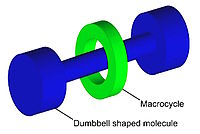
Photo from wikipedia
Four squaraine dyes derived from 2,3,3-trimethylindolenine and 1,1,2-trimethyl-1H-benzo[e]indole with different combinations of barbituric groups attach to the central ring, having ester groups and alkyl chains in the nitrogen atoms of… Click to show full abstract
Four squaraine dyes derived from 2,3,3-trimethylindolenine and 1,1,2-trimethyl-1H-benzo[e]indole with different combinations of barbituric groups attach to the central ring, having ester groups and alkyl chains in the nitrogen atoms of heterocyclic rings were synthesized. These dyes were fully characterized and their photophysical behavior was studied in ethanol and phosphate-buffered saline solution. Absorption and emission bands between 631 and 712 nm were detected, with the formation of aggregates in aqueous media, which is typical of this class of dyes. Tests carried out with 1,3-diphenylisobenzofuran allowed us to verify the ability of the dyes to produce singlet oxygen. The interaction of synthesized dyes with human serum albumin (HSA) was also evaluated, being demonstrated a linear correlation between fluorescence intensity and protein concentration. The antifungal potential of the dyes against the yeast Saccharomyces cerevisiae was evaluated using a broth microdilution assay. In order to test the photosensitizing capacity of the synthesized dyes, tests were carried out in the dark and with irradiation, using a custom-built light-emitting diode that emits close to the absorption wavelength of the studied dyes. The results showed that the interaction of dyes with HSA and the antifungal activity depends on the different structural modifications of the dyes.
Journal Title: Photochemistry and photobiology
Year Published: 2022
Link to full text (if available)
Share on Social Media: Sign Up to like & get
recommendations!